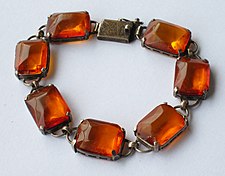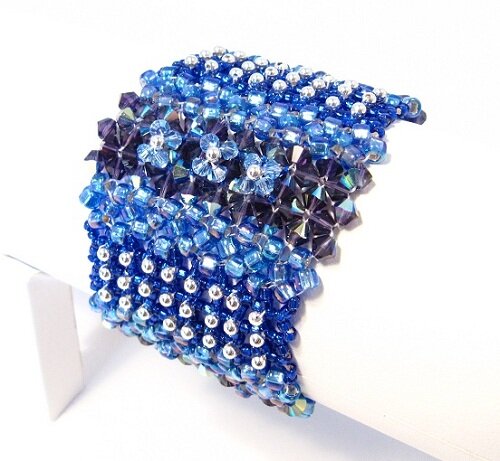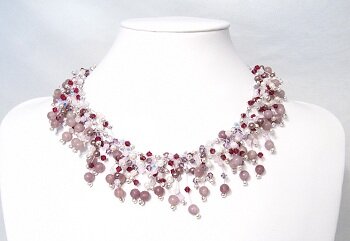
December 05, 2010
Hello,
welcome to the very first issue of The Jewelry And Poly News.
As a subscriber you will be montly updated on the happenings on my site www.Jewelry-and-polymerclay-tutorial-heaven.com, get the latest tutorials and see new jewelry added to The Jewelry Store. You will also receive the tip of the month.
Your feedback is very important to me. If there are things you miss on my site, or things you would like me to write about, please let me know. You can do so by responding to this mail when your receive the newsletter, or by using the -contact me- page on my site.
I hope you will enjoy this newsletter, just as much as I enjoy writing it for you!
All the best!
Anne Cecilie
In This Issue
News- Jewelry trends thorough time
- Body Jewelry – Barbaric,Provoking And Extreme Or A Blooming Trend In Fashion?
- Body Jewelry - Place Your Jewelry Right Where You Want It
- Timeless Elegance In A Small But Beautiful Package – The Pearl
- Amber – Prehistoric Gold And A Feast For Paleontologists
- Bone, horn and ivory
New tutorials
- Right Angle Weave - The Most Versatile Beading Stitch Of All
- Cobalt Blue Elegance With Right Angle Weave
- Beautiful Flower Earrings In Green And Peach
- Sparkling Crystal Feathers
New Items In The Jewelry Store
- Rocky Mountains Necklace
- Rocky Earrings
- Blue Lace Sapphire Necklace
The Tip Of The Month
- Design Your Necklaces On A Jewelry Display
News

Jewelry trends thorough time:
Jewelry has been a powerful tool for humans from the very beginning. Through out time it has been used for protection, to show of wealth, to show political status, as a token of love, for worshiping, for power, as payment, vanity and even to provoke.
The first signs of jewelry dates 75 000 years back, and were found in Africa. Materials that were easy to handle, like bone, seeds, wood, stone,teeth, shell and claws were the earliest forms of jewelry supply. And early jewelry may have been tools like needles of bone, worn around the neck for practical reasons. However shells on a strings have also been found, so wearing jewelry for decorative purposes came early in fashion, so to speak.
read more

Body Jewelry – Barbaric,Provoking And Extreme Or A Blooming Trend In Fashion?
Body jewelry is in reality a name for jewelry we put on our bodies, which can be finger rings, necklaces, bracelets or toe rings, but it is also a name for the more extreme use of jewelry - body piercing. Piercing means making a cut or puncturing a part on the body, creating an opening in which one can wear jewelry, or anything really, like sticks or safety pins.
If you are from a generation born before 1970's you may think this a bit extreme and linking it to the punk generation, a movement starting in Great Britten in the late 70s and early 80s. Punks were by many seen as something next to criminals, and their body piercing was seen as something provoking, used by rebellious youths to express their identity and individuality, opposing to the older generations. That picture is not entirely true. Punks brought piercing to a higher level, and created a new fashion trend, which was very popular in England in the early 80s.
Body Jewelry - Place Your Jewelry Right Where You Want It
Placements on your body:
Technically you can have a piercing anywhere on your body where you can make a hole. There are however some places that are more commonly used than others, and again others that are very private. Some piercings actually have their own name as well, named after who first introduced them, or by where it is placed on the body. Let's start with the least extreme ones.
Ears:
Pierced ears are overall accepted as an enhancement and has been for thousands of years. It has been worn by both women and men, in one ear or both. In the 1990s several piercings in the ears became modern in the western world, not only in the ear lobe, but along the whole length and width of the ear. read more
 Timeless Elegance In A Small But Beautiful Package – The Pearl
Timeless Elegance In A Small But Beautiful Package – The PearlSeductive, serene, mesmerizing and the true ambassador for elegance the pearl stands alone as the token of class and good taste. You can never fail, wearing pearls. They are timeless, they are beautiful and they are no longer hard to come by.
Pearls are believed to have been cherished and worn for more than 6000 years. The first known source of natural pearls was in the Persian Gulf, and the oldest one found was in a necklace of a Persian prince who died in 520 BC. Their written history dates back to a 23rd century BC Chinese book, where a scribe writes that a lesser king sent tribute of strings of pearls not quite round.
It is said that Cleopatra dissolved pearls in wine and drank them to enhance her beauty. Whether it worked or not is hidden in history. Busts found of Cleopatra do not portray her as a great beauty, so I have my doubt. She bathed in milk from donkeys also, but this page is not about Cleopatra, so I leave it at that.
Pearls popularity in ancient Rome was huge, but only upper class women were allowed to wear them. A Japanese should change that, but not before the early 1900s.
read more

Amber – Prehistoric Gold And A Feast For Paleontologists
Amber has a long history, pretty long actually, going back for millions of years. It is actually a fossil dating back to the time when dinosaurs roamed the earth, and even before that. The oldest findings are actually 345 million years old and are in Northcumberland USA, and that is pretty amazing, isn't it?
It was one of the first materials humans used for jewelry, some 30 000 years ago. People began trading with it and make objects from it some 11 000 years ago. Around 2500 BC Mediterranean countries used it in trade, and objects from that period have been found as far away as 600 miles from its origin.
Its ability to attract electricity was early seen as magical and the word electricity actually is derived from the Greek name for Amber – Electrum.
Amber was highly priced by the Romans and Emperor Nero acquired so much of it that he covered the entire stage for the gladiator fights with it. He even priced it higher than human slaves. In more resent times, Catherine the great of Russia created a whole room with panels and Florentine mosaic from Amber. This room was destroyed during the II world war, but is today reconstructed.
Bone, horn and ivory
Bone, horn and ivory are organic material, which means that they come from living organisms. They have been used for jewelry, ornaments and tools for thousands of years. They were probably among the first materials man shaped into something useful, like needles or knifes, since they were more malleable than stone. Needles and tools dating back to 34000 BC have been found. It probably came by naturally to use the leftovers from the animals they ate, and still does today.
Highly prized for their ability to be carved, shaped, dyed and polished it was only natural that they became some of the first jewelry making materials.
Besides Pearls, Amber and Jet, there are several organic materials used to make jewelry. There are coral, nuts, seeds, dinosaur eggs, only to mention a few. From the animal part of organic materials there are claws, fangs, teeth and even hooves, but the main materials used in jewelry making are bones, horns, antlers and ivory. read more
New Tutorials

Right Angle Weave - The Most Versatile Beading Stitch Of All
Right angle weave is one of the most exiting and fluid of all beading stitches. It can be done very simple but also very complex, depending on the colors, number and the sizes of the beads used. It is a wonderful stitch to use to make beaded jewelry design. It has a long history and originates from several countries, including Russia, Philippines and Japan.
Right angle weave is a very smooth and fluid beading technique, since you bead in circles, first to the right and then to the left and so on. Four and four beads are stitched together in right angle to each other, hence the name right angle weave. Done with very small seed-beads, it looks almost like fabric. Increasing and decreasing is easy, and it can therefor be stitched into close to all shapes desired.
You can use any number of beads, but all must be grouped into four, like each side of a square. Using several beads it is also called square netting stitch. see the rest of the tutorial

Cobalt Blue Elegance With Right Angle Weave
This bracelet is made with Right angle weave. It is such a beautiful bead weaving technique, with lots of potential to create stunning stuff. This bracelet is not so complicated, but still gives the impression of elegance, due to its cobalt blue and the sparkling Swarovski crystals.
What you need to make this right angle weave bracelet:
- #6 Dynamiteseed beads in Silver lined, square hole, rainbow blue.
- #11 Dynamite seed beads in Silver lined, square hole, cobalt blue.
- 4 mm Swarovski bicone crystals in Purple velvet AB.
- 2 mm round silver plated beads.
- 12 3 mm Swarovski bicone crystals in Sapphire AB.
- 2 cobalt blue round, faceted crystal beads, 8 mm.
- Fireline
- Elastic beading thread.
- Beading needle #12.
Step 1:
Cut a comfortable length of Fireline and tie the ends together with a surgeons knot. see the rest of the tutorial

Beautiful Flower Earrings In Green And Peach
These beautiful flower earrings are made by adding beads, and hold them in place with very thin wire. Varying the length of the twisted wire from the -stem- to the bead, gives the impression of flowers on a stem of silver. Since the wire is so flexible you can create vines of beads quite easily.
What you need:
- 4 glass leafs 12 x 9 mm, 2 peach AB and 2 green AB (AB= aurora borealis)
- Seedbeads #6, Rainbow transparent creamsoda (Dynamites)
- 18 green glass flowers, 7 mm
- Silver colored copper wire 0,4 mm
- 2 ear wires
- Wire cutters
- round nose pliers
Step 1:
Cut a 20 cm length of the 0,4 mm wire. Add a green glass leaf and slide it to the middle of the wire. Bend the wire in two and twist the wire to fasten the bead. see the rest of the tutorial

Sparkling Crystal Feathers
Can you ever get enough of crystal jewelry? This necklace looks like sparkling crystal feathers swirl around your neck. The combination of gemstones, crystals and glass pearls give a very elegant appearance. Adding the chain make the length ajustable.
To make it, you need:
- Swarovski 4 mm bicone crystals in Ruby, Vintage rose AB, Violet and Rose alabaster. Proximately 120 of each color
- 4 mm glass pearls in white and plum, proximately 50 of each.
- 60 6 mm round lilac stones
- proximately 150 2.5 mm crimp beads
- Proximately 150 3 mm crimp covers – silver plated.
- Beading wire 49 strands, 0.14 in. Pearl color.
- Chain nose pliers
- Jewelry glue
New Items In The Jewelry Store

Rocky Mountains Necklace: Lovely polymer clay nuggets in copper, gold and white.
Rocky earrings: Copper, gold and white earrings, made from Polymer clay.
Blue Lace Sapphire necklace: Lovely floating necklace with sparkling crystals.
Tip Of The Month

Design your necklaces on a necklace display
Creating certain types of necklaces can sometimes be a bit tricky regarding how you have to hold it to be able to make it. I like beading while I watch TV in the evenings, and tried different approaches with taping it onto a piece of paper, bead on a pillow etc., but non of them made it easier.
Eventually I tried making the necklace directly onto a necklace display, and that worked surprisingly well. Not only was it easier to work on the necklace, but it was easier to see how it would fall and look around the neck. You can hold the display in your lap while you work, and support it with a small pillow when needed.
You can also use it to display your jewelry when selling or showing them. Or you can take photos of your jewelry while it hangs on the display. It makes it easier for your customers to see how the necklace looks on.
If you make beaded collars, you can drape the textile around the display to see where you should put the notches for it to fall gracefully and not stand out on the sides of your neck.
Necklace displays are not so expensive, you can get some very good ones for proximately 10 USD. I find it a very valuable tool to use when I am making jewelry and simply just love it.



